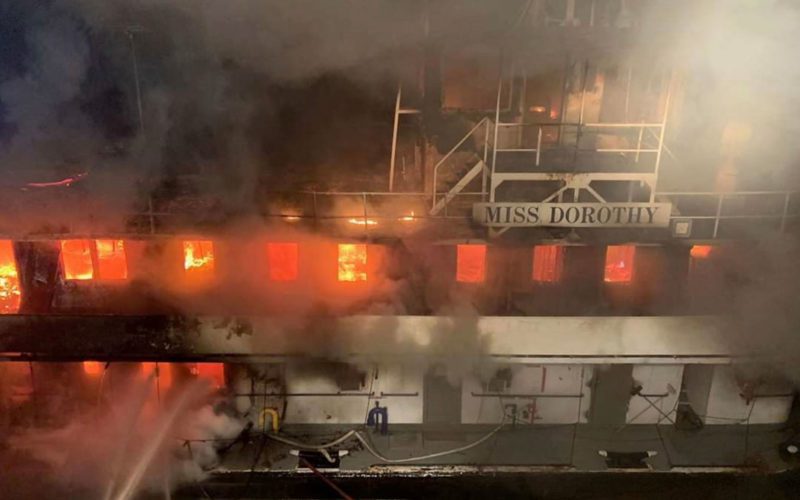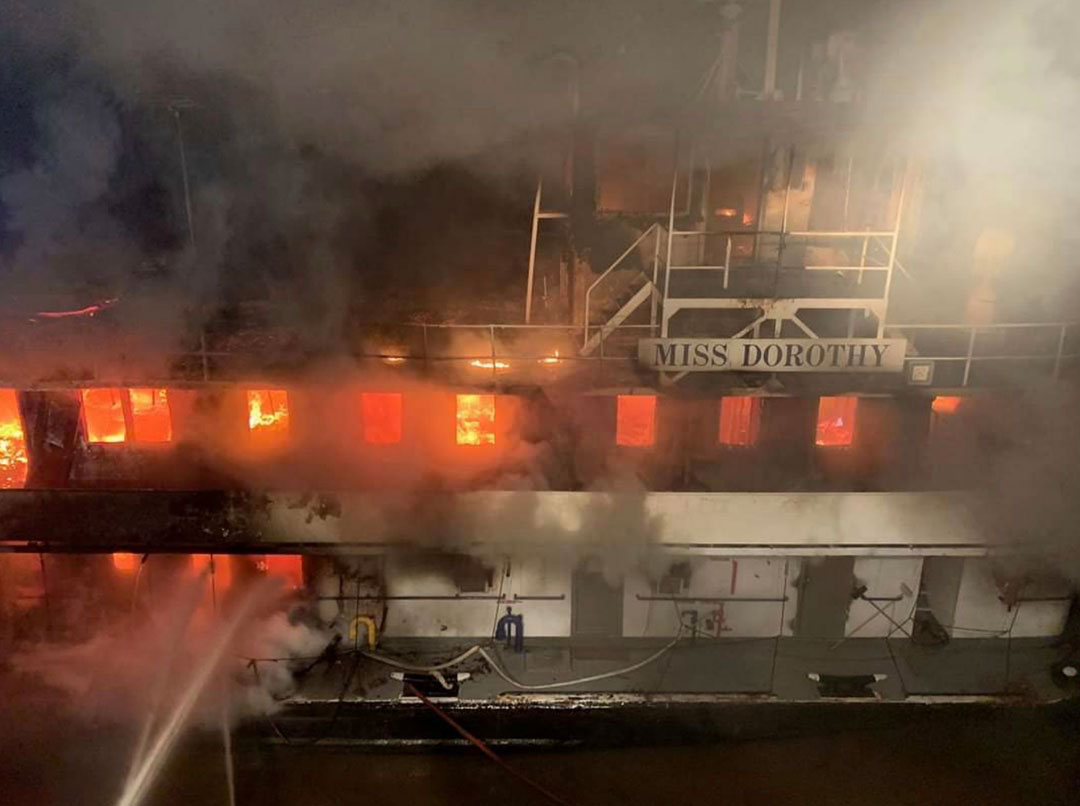
Nobody was hurt after a fire broke out in the engine room of a towboat pushing 14 barges up the Lower Mississippi River.
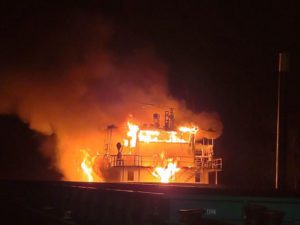 According to the National Transportation Safety Board (NTSB), the 155.8-foot Miss Dorothy was about 20 miles north of Baton Rouge, La., on March 17, 2021, when the incident occurred.
According to the National Transportation Safety Board (NTSB), the 155.8-foot Miss Dorothy was about 20 miles north of Baton Rouge, La., on March 17, 2021, when the incident occurred.
The eight crewmembers aboard attempted to fight the fire but were unsuccessful and evacuated onto its barges. They were rescued by crewmembers aboard the 157-foot towboat Christopher Wilson.
The NTSB determined the fire started after diesel fuel sprayed onto an uninsulated section of the engine’s exhaust system. “Contributing to the severity of the fire and damage to the vessel was the inability to effectively secure ventilation to the space and fuel to the affected engine,” the NTSB report continued.
No pollution or injuries were reported. Miss Dorothy sustained $2.4 million in damage. The 65-year-old vessel was a total loss. Western Rivers Boat Management of Paducah, Ky., owned the towboat.
Miss Dorothy began her last voyage March 16 at 0400 after leaving a fleeting area just north of the Sunshine Bridge at mile 168.5. The vessel was pushing one loaded equipment barge and 13 empties.
Its crew consisted of a captain, a pilot, a mate who was the lead deckhand, a chief engineer, a steersman and three deck hands. They were scheduled to make an 850-mile northbound trip to a loading facility on the Cumberland River.
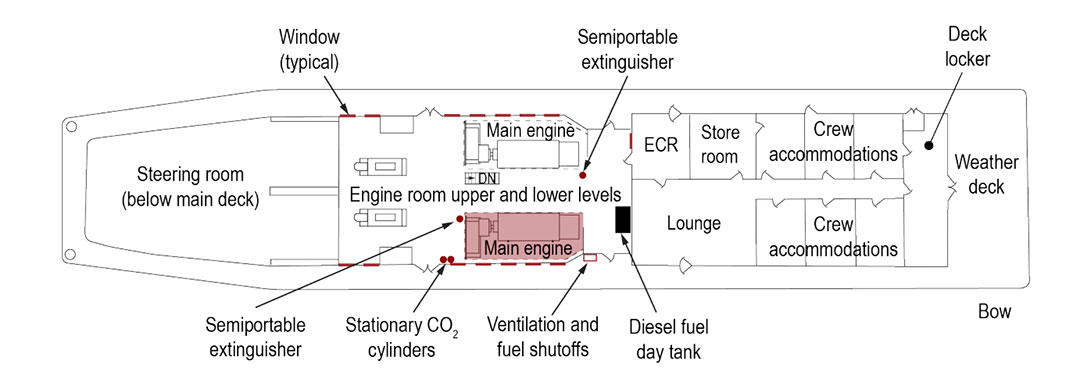
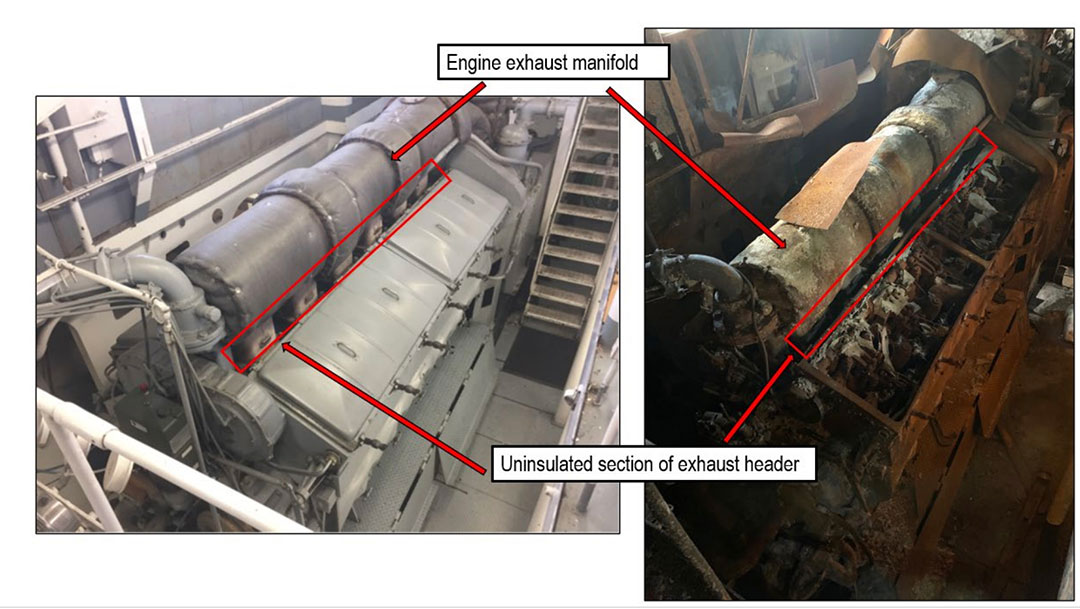
The report explained that the crew said the vessel was in great condition with machinery in working order until the fire. A chart shows the river width is 2,000 feet at the site of the incident and the current is 5 to 6 miles per hour.
The mate checked the vessel’s engine room at 2300 on March 16. Fire alarms sounded within the wheelhouse and throughout the vessel about an hour and 45 minutes later at 0045.
“Withing 30 seconds of the alarm sounding, the pilot could see smoke that ‘grew in intensity very quickly’ coming from the engine room, and he immediately activated the vessel’s general alarm,” the report said.
After the crew awoke, they began running fire hoses on the starboard side of the main deck to fight the fire. Within two minutes of the fire alarm sounding, the captain relieved the pilot at the controls and attempted to notify the U.S. Coast Guard.
When that attempt to communicate failed, the captain established communications with Christopher Wilson and learned that the Coast Guard Sector New Orleans had received the distress call and was attempting to respond.
Miss Dorothy’s pilothouse was filling with smoke and the captain could see the glow of flames coming from the stern of the vessel, according to the report. The crew could not stop the flames and at about 0052 the captain ordered the crew to abandon ship. They escaped to the tow’s barges at about 0100.
While on the barges, the crew of Miss Dorothy remained in contact with the crew of Christopher Wilson. That vessel was tying off its tow to shore several miles downriver to better assist the distressed vessel.
After 45 minutes, the crew of Christopher Wilson arrived to help. The fire had engulfed the superstructure of Miss Dorothy but they were able to push the vessel and its tow into a descending bank at mile 244 after picking up the stranded crew.
Members of the East Baton Rouge Sheriff’s Office Marine Division, the Baton Rouge Fire Department and the St. George Fire Department boarded a 45-foot fire boat and launched to assist. They arrived on the scene at 0330, according to the report. An ExxonMobil Refinery fire boat with suppression foam arrived to help as well.
By 0505, the superstructure fire was out and the engine room was declared extinguished at 0940.
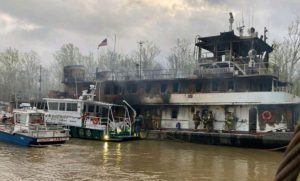
injuries.
Christopher Wilson towed Miss Dorothy to Calvert City, Ky., where it was declared a total loss as the engine room, storerooms, accommodations and wheelhouse were destroyed.
According to the report, a post-casualty examination of the vessel showed that the half-inch fuel oil return line from the left bank of the starboard main engine located on the forward end of the engine had been displaced from its connection flange. A section of exhaust header for the forward inboard cylinder of the starboard engine was about three feet from the fuel oil pump end of the starboard main engine and the fuel oil return line that was disconnected.
A forensic fire investigator determined that an uninsulated exhaust header acted as an ignition point for atomized, or spraying, diesel fuel.
The chief engineer attempted to shut fuel to both engines despite the intense heat, and he succeeded in pulling the shutoff for the starboard engine. However, post-accident investigation found the shut-off valves in the day tanks remained open, likely feeding the fire for some time.
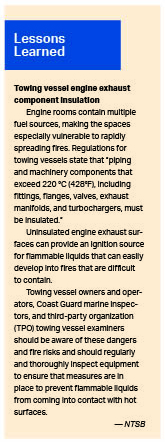 Crew attempted to use handheld fire extinguishers to fight the flames, although they had little effect on a diesel-fed fire, the report said. Other firefighting equipment was stored in the engine room and therefore inaccessible during the immediate response.
Crew attempted to use handheld fire extinguishers to fight the flames, although they had little effect on a diesel-fed fire, the report said. Other firefighting equipment was stored in the engine room and therefore inaccessible during the immediate response.
Authorities determined that if Miss Dorothy had a fixed fire extinguishing system in the engine room or another effective means to starve the fire of oxygen, it likely could have been extinguished or contained to that space. The vessel was not required by existing regulations to have such a system.
“Without an effective means to isolate the diesel fuel feeding the fire, secure the ventilation supplying oxygen to the fire, or fight the fire using onboard equipment, the crew were forced to evacuate the vessel onto the tow’s barges as the fire grew,” NTSB investigators said in the report.
Western Rivers Boat Management declined to comment on the NTSB report by Professional Mariner’s press deadline.

